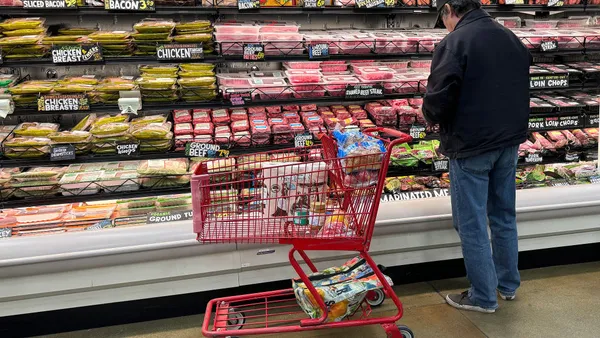Dive Brief:
- Millennials are increasingly shopping for produce outside of traditional grocery stores, according to the Food Marketing Institute's 2019 Power of Produce report. Just 34% of millennials surveyed reported a supermarket as their primary source for produce.
- Supermarkets draw about 51% of all produce sales, but competition is growing from natural grocers, farmers markets and limited assortment stores. Supermarket operators will need to offer a specialty assortment, including locally sourced items, unique offerings and value-added produce such as pre-sliced fruit and microwave-ready vegetables, to meet consumer preferences.
- Only 20% of shoppers purchase some fresh produce online, despite the rise in e-commerce. Millennials, urban and high-income shoppers are the most likely to switch between online and in-store when buying fresh produce, the report said.
Dive Insight:
With $60 billion in annual sales, produce continues to be a powerful category for food retailers, and there is even more growth potential since just 41% of consumers eat produce on a daily basis, the report said. Produce was the slowest growing perishable category in 2018 with a 1.7% increase in sales, but the Power of Produce highlights a number of shifts happening within the category that suggests retailers should freshen up their efforts in the space.
Efficient food solutions are more in demand than ever, and produce is no exception. Packaged produce has grown to 53% of total produce sales, and grocers that offer cut, chopped, halved or snack packs of produce can help drive bigger baskets among shoppers who are happy to pay premiums for prepared goods. The demand for fruit smoothies and veggie shakes, purchased by 56% of shoppers, is increasing for the same reason. Consumers looking for a quick health fix will choose stores that offer their favorite healthy beverages. Packaged produce and salad kits, which have grown 20% in the past year, are also growing in popularity as another time-saving selection.
Locally grown produce matters to 84% of shoppers, and it's especially important to people who also seek out other "growing-related claims," including organic, sustainably-grown and non-GMO. Retailers have a significant opportunity to boost their selection of local and sustainably grown goods, and offer a more diverse lineup of produce to increase customer spending.
Greenhouse-grown or hydroponic-grown produce is also gaining ground with 41% of shoppers having tried an item, and these unique produce items can help drive sales, the report said. Shoppers will continue to see increased selection for this type of produce as companies like BrightFarms expand and traditional grocers experiment with the technology, such as Hy-Vee's ultra-local produce from in-store "grow walls."
Produce purveyors should also find ways to share compelling backstories about produce with shoppers, such as information about the farm from where it came. This replicates the farmers market experience and helps shoppers better understand the produce they are purchasing, the report states. The story element is a particularly effective marketing strategy for millennials who prefer experience-oriented products and are more likely to go to farmers markets for produce. Consumers are curious about how food is grown, and providing education about label claims like non-GMO or Certified Naturally Grown can help draw sales and strengthen customer loyalty.
Though most shoppers still prefer to feel, touch, smell and compare their produce items in-store, a growing contingent of shoppers are purchasing produce online. If traditional supermarkets can offer the right selection and tie their online offerings back to the trustworthy in-store experience they provide, they are more likely to capture the online spend from customers.
Grocery stores are still major players in fresh produce sales, and there is more opportunity than ever to be creative in the category and connect with customers with a robust produce offering that is transparent, convenient, local and fresh.









